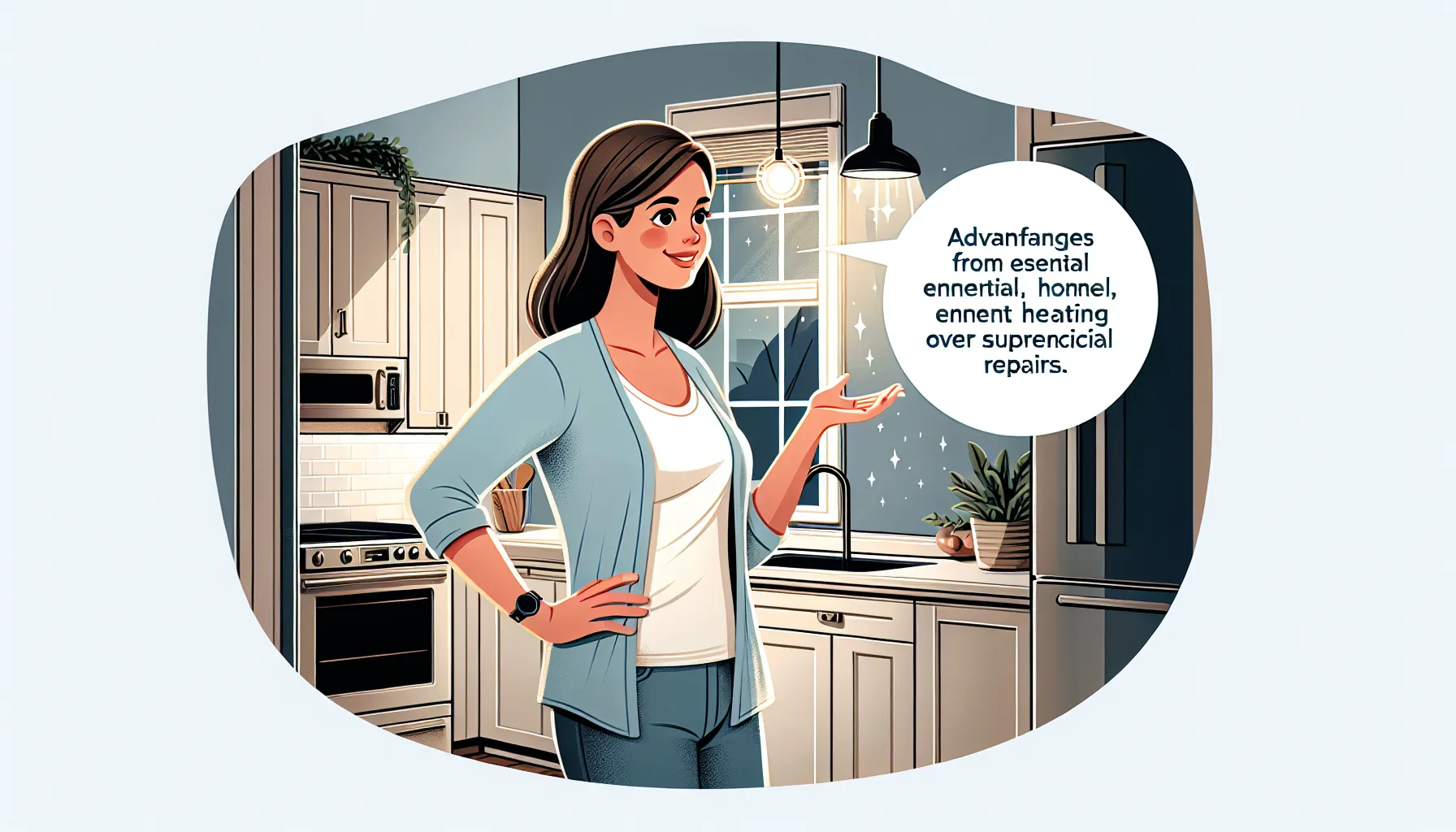Key Takeaways
- Focus on Major Features: Prioritize repairs that enhance essential home features, such as roof condition and major appliances, rather than minor cosmetic issues.
- Skip Minor Cosmetic Fixes: Small dents or scuffed paint are usually overlooked by buyers and do not warrant significant investment or time.
- Avoid Overhauling Appliances: Replacing outdated appliances often doesn’t yield a return and allows buyers to envision their preferences for upgrades.
- Limit Landscaping Investments: Basic landscaping maintenance is sufficient for curb appeal, while extensive renovations may not pay off.
- Handle Only Major Plumbing and Electrical Issues: Small plumbing problems can often be addressed during negotiations, while significant issues should be fixed to maintain buyer confidence.
- Understand Buyer Priorities: Buyers value functionality, safety, and location over aesthetic updates, so focus on repairs that genuinely enhance the living experience.
Selling a house can feel overwhelming, especially when we’re faced with the urge to fix everything that seems off. But what if we told you that not all repairs are worth the hassle? In fact, some fixes can actually waste our time and money without adding value to the sale.
Don’t Fix These 7 Things When Selling Your House
Many homeowners believe that fixing various issues before selling their house enhances its appeal. However, some repairs may not yield a return on investment. We’ll outline seven areas where skipping repairs could benefit the selling process without diminishing property value.
- Minor Cosmetic Flaws
We often see homes with scuffed walls or worn carpet that owners feel compelled to fix. Buyers usually understand that these minor cosmetic issues are easy to address post-purchase. Instead of investing time and money in painting or carpet replacements, we recommend leaving these flaws as they are.
- Outdated Appliances
Replacing appliances can significantly impact budgets without guaranteeing a sale increase. Many buyers have preferences for specific brands or models that vary from what we install. Keeping older appliances allows buyers to envision personal upgrades, making this a non-essential repair.
- Bathroom Updates
We frequently advise against extensive renovations in bathrooms, such as new tiles or fixtures. New homeowners often prefer to design their spaces according to their style. We can highlight the bathroom’s space and functionality without overspending on trendy updates.
- Landscaping Overhaul
While curb appeal matters, we shouldn’t invest heavily in landscaping projects. Basic maintenance, such as mowing the lawn and trimming hedges, provides enough appeal. Overhauling landscaping may not yield the expected value return and can deter prospective buyers.
- Basement Finishing
Finishing a basement costs considerably and often doesn’t align with buyer preferences. Many buyers value basement space for functionality, not aesthetics. Maintaining the basement for storage instead can efficiently serve our selling strategy.
- Roof Replacement
Replacing a roof before selling typically requires funds that don’t translate to higher sale prices. Buyers prefer negotiating roof conditions during the sale rather than us absorbing upfront costs they may perceive differently.
- Wiring and Plumbing
Fixing wiring or plumbing issues can become costly and may not deliver immediate value. Home inspectors often check these systems, and addressing major issues instead allows us to provide transparency to buyers during negotiations.
In essence, we should focus on the features that make our homes sellable while avoiding repairs that won’t add tangible value. Prioritizing essential repairs while letting buyers envision their touches can lead to a smoother sale.
Common Misconceptions About Home Repairs

Many homeowners hold misconceptions about what repairs truly add value to a property. Understanding these notions can help us streamline the selling process and focus on what really matters.
Understanding Buyer Priorities
Buyers often emphasize features that directly impact their living experience rather than cosmetic fixes. They prioritize functionality and location over minor aesthetic issues. For instance, buyers value spacious kitchens or updated HVAC systems above freshly painted walls. By understanding these priorities, we can avoid unnecessary repairs while highlighting the home’s key strengths. Focusing on essentials, such as the condition of major appliances or the roof, aligns more with buyer interests, making the property more appealing.
Cost vs. Value Analysis
Investing in many repairs doesn’t always equate to increased value. A cost vs. value analysis shows that some improvements return little on investment. For example, a major kitchen remodel may cost around $70,000 but only recoup about 60% of that investment upon sale. Conversely, maintaining the existing appliances can satisfy buyers without excessive spending. By concentrating our resources on inspections and necessary repairs, we can present a well-maintained home without overspending on updates that won’t significantly impact the overall selling price.
The Seven Things You Shouldn’t Fix
In the process of selling a house, we often encounter pressure to make repairs. However, not every fix adds value. Here’s a rundown of seven things we shouldn’t invest time or money into fixing before listing our property.
1. Minor Cosmetic Issues
Minor cosmetic issues, like small dents or scuffed paint, usually don’t warrant our attention. Buyers often overlook these small flaws, focusing instead on the home’s overall appeal and functionality. For example, a worn doorknob or a faded wall can be easily remedied by a fresh coat of paint or a simple cleaning. When we emphasize larger selling points like spacious living areas or modern amenities, these small imperfections fade into the background.
2. Outdated Fixtures
Outdated light fixtures or cabinet knobs don’t significantly impact buyers’ decisions. Often, prospective buyers visualize their own upgrades, allowing them to overlook these small details. We might consider leaving such fixtures as they are, as most buyers may not view them as deal-breakers. By not replacing every outdated fixture, we preserve our budget for other aspects of the sale that genuinely influence value.
3. Landscaping That Doesn’t Matter
Investing heavily in landscaping can yield diminishing returns. While curb appeal is essential, we shouldn’t overdo it with extensive garden renovations. Simple maintenance, like mowing the lawn and trimming shrubs, can go a long way without the necessity for costly redesigns. Buyers often prefer easy-to-maintain yards over extravagant landscapes, making it unnecessary to spend on elaborate gardening.
4. Old Paint Jobs
Old paint jobs might not merit a complete repainting before selling. A new coat may not significantly enhance value, especially if the home is clean and well-maintained. We can focus on touch-ups for damaged areas while allowing buyers the opportunity to customize colors later. This strategy saves us time and resources, ensuring we don’t overcrowd the budget with unnecessary renovations.
5. Age of Appliances
Older appliances don’t always need replacement when selling a home. If they function well and don’t indicate a safety hazard, buyers may accept them as part of the deal. Some buyers prefer negotiating appliance upgrades as part of their purchase, giving us an avenue to showcase the home’s functional aspects rather than strictly focusing on aesthetics. Therefore, leaving appliances as-is can be a sound decision.
6. Personal Taste Items
Personal taste items, such as unique decor or wallpaper, might seem like they should be changed. However, what appeals to one buyer might not appeal to another. Removing all personal touches can strip the home of its character, making it feel less inviting. Instead, we might allow buyers to visualize their style within the space and simply declutter to highlight the home’s potential.
7. Small Plumbing Problems
Small plumbing issues—like a slightly leaky faucet—often scare sellers into costly repairs. Yet, many buyers factor in minor repairs during negotiations, viewing them as part of their responsibilities post-purchase. We can document these existing issues and transparently communicate them to potential buyers, ensuring we maintain trust while avoiding unnecessary expenses. By doing so, we focus on the larger selling points of the home.
When to Consider Repairs

Understanding when to make repairs can significantly impact our selling strategy. Repairs become crucial when they affect the home’s safety, structural integrity, or functionality. For example, addressing significant roof issues or major plumbing leaks is essential as they can deter buyers or lead to severe complications during closing. Ignoring these repairs can result in more significant problems and costs down the line.
Historically, buyers expect homes to be in good working condition. We benefit from taking care of crucial repairs like faulty electrical systems or heating issues that can directly influence buyer comfort and confidence. If not resolved, potential buyers might perceive these problems as red flags, reducing our negotiating power.
We should also consider repairs that could drastically enhance our property’s appeal. Upgrading kitchens or bathrooms often attracts potential buyers and improves our sale price. Buyers frequently seek modern amenities, so investing in necessary updates can yield high returns.
On the other hand, we don’t need to overinvest in repairs that have minimal impact on value. Cosmetic fixes and personal style items typically don’t drive buyer interest. Understanding these nuances helps us prioritize effectively, ensuring that time and resources are used for impactful improvements.
We must also evaluate the general market conditions. In a strong seller’s market, buyers may be less concerned about minor repairs. On the contrary, in a buyer’s market, addressing essential repairs could set our property apart. Balancing repair decisions with market dynamics can guide us in navigating a successful sale.
Conclusion
Selling our house doesn’t have to mean pouring money into unnecessary repairs. By understanding which updates truly matter we can save time and resources. The seven areas we’ve discussed highlight that many cosmetic fixes won’t significantly impact buyer interest or property value.
Instead of focusing on minor flaws or outdated appliances we should prioritize essential repairs that ensure safety and functionality. This approach not only streamlines the selling process but also helps us present a home that appeals to buyers without overspending.
By letting go of the pressure to fix everything we can make informed decisions that align with our goals and the current market conditions. Ultimately it’s about showcasing our home’s true potential while keeping costs in check.
Frequently Asked Questions
What are the main challenges of selling a house?
Selling a house can be challenging due to the pressure to make numerous repairs before listing. Homeowners often invest time and money in repairs that may not significantly increase the property’s value, complicating the selling process.
Which repairs should homeowners skip before selling their homes?
Homeowners can skip minor cosmetic repairs, replacing outdated appliances, extensive bathroom renovations, heavy landscaping investments, finishing basements, roof replacements, and making significant wiring or plumbing repairs. These often do not add value and can be a waste of resources.
Why are minor cosmetic fixes not necessary when selling?
Minor cosmetic issues, like old paint or small flaws, can be overlooked by buyers who prioritize the home’s overall appeal and functionality. Spending too much on these fixes may not yield a good return on investment.
Do outdated appliances need to be replaced before selling?
Outdated appliances do not need to be replaced as long as they function well. Buyers often appreciate that they can upgrade appliances to their preference rather than forcing sellers to invest in costly replacements.
Is it worth investing in landscaping before selling?
Heavy landscaping investments are generally unnecessary. Basic maintenance, such as mowing the lawn and trimming shrubs, suffices. A well-kept exterior is appealing without the need for extensive landscaping work.
Should sellers consider plumbing and wiring repairs?
Minor plumbing and wiring issues can be addressed selectively. Buyers often factor in these issues during negotiations, so fixing significant problems can enhance buyer confidence without overspending on small fixes.
How do market conditions affect repair decisions when selling?
Market conditions influence the urgency of repairs. In a seller’s market, less emphasis is placed on repairs, while in a buyer’s market, addressing critical issues may be necessary to attract potential buyers and close a sale.






